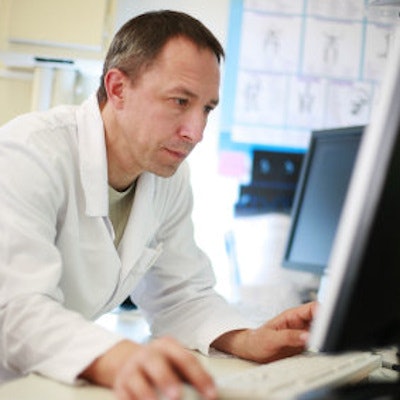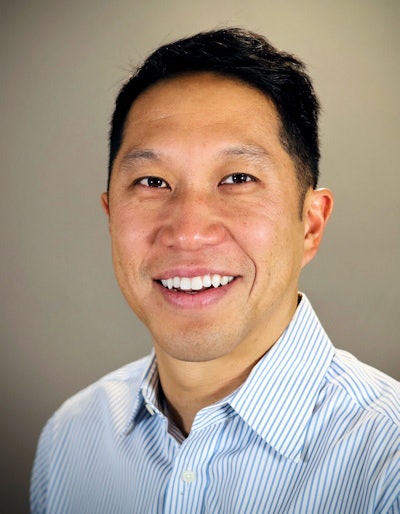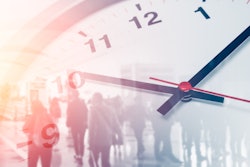
As a radiologist, there's a peculiar phenomenon I've noticed. When you're busy, you're REALLY BUSY! But it isn't just that. It's that during those times, you're so busy, but you simultaneously feel like you're not getting any "real" work done. Am I alone?
 Dr. Roy Kwak.
Dr. Roy Kwak.It's not in your head. It's how our work is structured. In this two-part post, I'll explain my thoughts on what I believe is going on, why it's unique to radiology, and some general ideas on how we can approach it.
With my previous group, our strategy to meet competing demands of being physically available and manageable shift lengths was by using staggered shifts. In simple terms, one person came in at 7 a.m. covering the list for multiple sites and was slated to leave at 3 p.m. The next person would start at 9 a.m. and leave at 5 p.m.
In our practice, everyone was responsible for doing basic procedures like thoracentesis, paracentesis, guided biopsies, fluoroscopy, needle localizations, etc. A teleradiology group covered us in the evenings, leaving prelims on cross-sectional studies and leaving all x-rays for the morning crew. If you were the early morning person, you were guaranteed a robust worklist when you started.
I remember many of those mornings, usually when I started with an especially long list from the get-go. It was hard to even read a handful of cases before the other guy arrived. I'd sit down, open a list of over a hundred cases, then the phone would ring, a clinician would walk into the reading room, a technologist would come in with paperwork for a procedure, and my hair was immediately on fire.
I hit the ground sprinting, and more often than not, I'd be full throttle till the end of the day. This was because I was simultaneously trying to make progress on my list (the "real work") and dealing with issues that required my immediate attention.
On the other hand, sometimes I'd arrive and the workload was noticeably more chill ... you could walk to the cafeteria, get a cup of coffee, chat with the technologists, etc. And on these days, I could potentially get a lot of "work" done.
Why does the switch between these two gears feel so jarring? It's like there are no midrange gears in between. What accounts for this phenomenon of "when it's chill, it's chill, and when it's busy, it's so busy that it's hard to get work done?"
Isn't it obvious? Isn't this just the normal ebb and flow of work in a hospital? Well, yes ... and no. It is related, but there's a more interesting structural issue with what we do and how we do it. But before we can get into that, we need to first break down the more "first-order" reasons for daily workload volatility.
Reasons for the variations in daily busyness include the following:
1) Normal ebb and flow of patient volume. We all inherently understand this. More patients mean more imaging, more procedures, more calls, etc.
2) Fires. Often, things don't go smoothly at work. This can contribute to a complete car crash scenario when it comes to getting things done. Someone codes in the CT scanner, a patient has an allergy to contrast, a patient isn't doing well after a procedure, etc. We've all experienced this and know how it can bring your productivity to a screeching halt. Sometimes it can take an inordinate amount of time to deal with an emergency or problem. During this time, you are forced to neglect your, usually growing, worklist.
3) The Dump. No one likes to arrive to a pile of unfinished work, but sometimes that's just what happens. Whether it be an ill colleague, an especially busy shift before yours, or sometimes it's how we've chosen to structure our workflow. The upside is that you're guaranteed a continuous stream of work. The downside is that you have a giant inbox and the accompanying anxiety to get through it all.
4) Complex or difficult cases. This is pretty self-explanatory. Some days we just have a string of normal head CTs on our list and we cruise through the worklist. And some days, every study feels like a train wreck: complex polytrauma, metastatic cancer, or just a ton of relevant priors. There just isn't an easy way to get around these cases or days.
5) Not being "present." We've all experienced this. You're at work but you are not really "at work." It could be a mental thing like when you have to deal with nonwork-related items, like your kids' school issues, Facebook, Instagram, politics, online shopping, etc ... or it could be physical, like having to attend meetings or deal with tedious administrative tasks.
6) Your team is not "present," either physically or mentally. This is when your co-radiologist(s) are similarly distracted, reading inefficiently, or involved in other activities that are not directly work-related. Maybe they're the ones who are distracted online or dealing with childcare issues ... or maybe they're in an administrative position and stuck in meetings all day. The point being that sometimes there are effectively fewer full-time equivalents (FTE) than there should be for the given work volume.
7) Broken systems. Often a lot of the "fires" mentioned above are actually issues that could be addressed by improving departmental systems. Do the techs need to call you every time there is a procedure to know which size gloves you need? When there is a contrast reaction, are the staff properly trained and drilled in the management of the situation so the degree of radiologist involvement is streamlined, or does it become a circus with people trying to find a long lost blood pressure cuff or stethoscope?
This is a deep and ranging topic, but suffice it to say that rarely is enough thought directed toward fixing these systems, especially in busy growing practices.
I've outlined all of the major categories of reasons that radiologists may feel especially busy at work.
But going back to my original point, the frustrating part about these crunch times is that even though we may be really stressed and "busy," our productivity declines steeply. Like it or not, as radiologists we are "paid by the click" and by productivity, I am specifically referring to how many cases we read per unit time.
I'd like to propose another model to reframe the "busyness" that we feel as radiologists. This model incorporates all of the above categories, but it also includes a couple of new ideas that will help explain the funny relationship between "busy" and the inability to get any work done ... the drop in productivity that we feel so viscerally.
I'll call these new ideas the "quantum unit of work" and the "time tax." My next post will fully explain this new model and how these new ideas fit into it. This will allow us to begin addressing, or at least shine a light on, these productivity issues in our radiology reading rooms.
Dr. Roy Kwak is a neuroradiologist based in Southern California. He's also the creator of RadsBest, which helps radiologists make faster decisions and craft better reports. His Instagram page is @medocratic; this article was originally published on his Medium page.
The comments and observations expressed herein are those of the author and do not necessarily reflect the opinions of AuntMinnie.com.



















